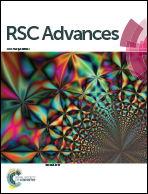Mesoporous In2O3 nanofibers assembled by ultrafine nanoparticles as a high capacity anode for Li-ion batteries†
Abstract
As a lithium storage material, In2O3 has been hindered by its rapid capacity degradation due to the very large volume change during the repeated lithiation and delithiation process, although an initial discharge capacity of more than 1600 mA h g−1 has been reported. In this work, the mesoporous In2O3 nanofibers with ultrafine In2O3 nanoparticles were synthesized by a cost-effective method. The mesopores within the nanofiber matrix allow more Li+ to enter the interface of the material, achieving a high utilization of the In2O3 electrode. The volume change during alloying and de-alloying of lithium and indium has been greatly alleviated within this unique mesoporous nanofiber structure, which kept a better integrity of the electrode and a high cycle stability of the LIBs as well. The ultrafine In2O3 nanoparticles shorten the diffusion path of the electrons and lithium ions and exhibited excellent cycle stability and a very encouraging specific capacity (526.7 mA h g−1 in the 200th cycle at a current density of 100 mA g−1) as an anode for LIBs.


 Please wait while we load your content...
Please wait while we load your content...